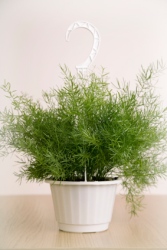Department of Agriculture plant. Can be grown outside in the summer 5 - 10 H2.

Asparagus Fern Care Growing Asparagus Ferns Bbc Gardeners World Magazine Source: www.gardenersworld.com
Considered perennial in US.

Asparagus fern temperature range. Minimum temperature ranges in degrees C are shown in brackets. The leaves are in fact needle-like cladodes modified stems in the axils of scale leaves. Asparagus requires a temperature range of 75 to 85 degrees Fahrenheit during the growing season.
Asparagus tolerates great temperature variations. It grows in the Imperial Valley of Southern California where temperatures can reach 115 F and it grows in Minnesota where temperatures can plunge to -40 F. Asparagus is a herbaceous perennial plant growing to 100150 cm 4060 in tall with stout stems with much-branched feathery foliage.
Asparagus setaceus in particular thrives in humidity so a bright bathroom is the ideal place for it. Asparagus can be grown in a wide range of soils and under various climatic conditions. And then in the springtime you shall notice shoots growing up even when the soil temperature is at 50 degrees Fahrenheit.
Plants need temperatures to be between 75 to 85 degrees Fahrenheit during the daytime and 60. All ratings refer to the UK growing conditions unless otherwise stated. They like being pot bound but you will have to divide them every two years because the mass of tubers will fill the container and prevent proper drainage.
They are 632 mm 1 4 1 1 4 in long and 1 mm 1 32 in broad and clustered four to 15 together in a rose-like shape. The Plumosa fern will thrive in loose well-aerated and consistently moist soil. Average room temperatures are ideal for growing asparagus ferns.
The room should be between 55F and 70F. Asparagus densiflorus Myers Foxtail Fern Asparagus densiflorus Sprengeri Sprengeri Asparagus Asparagus setaceus Plumosa Fern. The drop in night.
All ratings refer to the UK growing conditions unless otherwise stated. Asparagus fern Asparagus fern is a sprawling shrub native to coastal southeastern South Africa. Asparagus produces best in well drained medium textured soils but will grow in a range of soil conditions.
Asparagus ferns do best in bright but indirect light out of direct sunshine. Native to South Africa. Light The best light for asparagus ferns is bright indirect light or.
Since they tolerate more sun than true ferns asparagus ferns are good choices where the fine texture of ferns is desired in fairly sunny locations. When growing asparagus ferns as houseplants its vital to protect them from temperature extremes. Asparagus is adaptable to temperate regions where low temperature or drought give the crop a rest period.
It grows in the Imperial Valley of Southern California where temperatures can reach 115 F and it grows in Minnesota where temperatures can plunge to -40 F. The optimum range for germination is 16 to 30 C. So keep the fern-like plants protected from direct sunlight and out of drafts.
Asparagus ferns thrive outdoors in warm humid climates where temperatures stay above 70 degrees Fahrenheit. For the asparagus fern to stay evergreen winter temperatures need to stay above 49 degrees Fahrenheit. Temperature range for most indoor plants is a daytime temperature of 65ºF to 75ºF 18ºC to 24ºC and a nighttime temperature about 10 degrees cooler.
Grows on sandy or skeletal soils in warm temperate regions within a temperature range of 10 to 20 o C and rainfall from 500 to 1500 mm annually. It can tolerate varying soil types but aeration and drainage cannot be compromised. Keep away from draughts and radiators.
The crop does well under cool season conditions. It will not tolerate extreme acid soil conditions and grows best at a pH of 65-70. Tolerant of low temperatures but not surviving being frozen 1 to 5.
It prefers acidic soil types. Optimum growing temperatures are 65-80F 18-26C. In fact they generally prefer daytime temperatures below 72 degrees Fahrenheit and night-time temperatures below 60 degrees F.
H1a - Under glass all year 15C H1b - Can be grown outside in the summer 10 - 15 H1c - Can be grown outside in the summer 5 - 10 H2 - Tolerant of low temperatures but not surviving being frozen 1 to 5. Asparagus can be grown in a wide range of soils and under various climatic conditions but it. Asparagus plants are sensitive to changes in temperature.
Under glass all year 15C H1b. They need a minimum temperature of 13C. Asparagus tolerates great temperature variations.
The optimal temperature range for asparagus plumosa ferns is 65F to 70F 18C 21C. Map showing the present distribution of this weed. The optimum temperature for germination is 24 C.
Fern asparagus are pretty tough plants but once temperatures drop to 20 degrees Fahrenheit or below the plant can suffer burn back of its foliage. It needs frequent watering every time the top few inches of soil dry out. Warm temperate regions growing within a temperature range of 10 to 20 C and rainfall from 500 to 1500mm annually.
It also grows very well in a terrarium. Can be grown outside in the summer 10 - 15 H1c. Despite the common name it is not a true fern but is in the asparagus family Asparagaceae or the lily family Liliaceae which includes plants such as amaryllis daylilies hosta and tulips depending on the classification system used.
Minimum temperature ranges in degrees C are shown in brackets. It is preferred that the temperature stays between 60 to 80 degrees at night. However the rate of growth is temperature sensitive.
Asparagus ferns prefer cooler temperatures. The minimum temperature for germination is 10 C.

Asparagus Fern Better Homes Gardens Source: www.bhg.com

How To Care For An Asparagus Fern 12 Steps With Pictures Source: www.wikihow.com

Gardening 101 Asparagus Ferns Gardenista Source: www.gardenista.com

Care Of Asparagus Fern Asparagus Densiflorus Sprengeri Source: www.guide-to-houseplants.com

Plumosa Fern Complete Care Guide Garden For Indoor Source: gardenforindoor.com

Foxtail Fern How To Grow Asparagus Fern Care Of Foxtail Fern Source: naturebring.com
